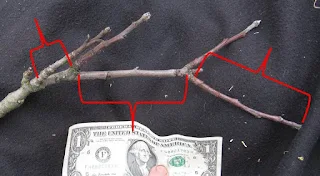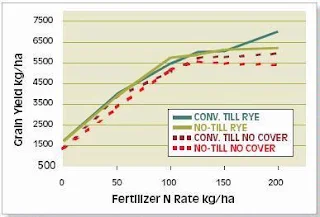 |
| A dollar bill is about 6" long. My target is for most terminal twigs to grow 12"-to-15" every year. |
 |
| In silhouette |
 |
| The presence of lichens and moss are another indicator of low fertility. Lots of fruiting spurs. Not much stem length to carry leaves. |
It takes leaves to make sugar.
It takes Nitrogen (Nitrogen will be capitalized when I discuss it as a fertilizer) to make leaves. Between two and three pounds of Nitrogen is needed to produce one hundred pounds of leaves (dry weight).
 |
| Fruit size, color and soluble solids all correlate. 180 grams-to-200 gram fruit generally gets the best price. That equates to 25-to-50 fruit per cubic meter of canopy for this cultivar (Honeycrisp) on this rootstock (M26) in Nova Scotia with the tree training systems investigated. Source |
Needs Nitrogen. But how much?
Most C-3 crops (in the mid-West) show flatted response to N applications over 200 pounds per acre. By some happy accident, kg/ha is close enough to lb/acre to be almost interchangeable. The 200 lb/acre number depends on rainfall. More rain means more N can be used. In dry years N response can flat-line at 100 pounds per acre.
Apples are a C-3 crop.
One complication is that I do not want to fertilize the grass growing in the lanes between the trees. More vigorous grass means more competition for moisture. Salamander's orchard does not have irrigation. A second reason I do not want to run maximum N due to risk of fire-blight. These trees have already filled their space. A third reason is that excessive Nitrogen causes more suckers to grow. Removing suckers is labor.
So how does that pencil out in a way that is grower friendly?
Consider that each apple has a canopy of approximately 15 feet diameter. A 15' diameter circle has a shadow area of 175 while a 15' square has a shadow area of 225 square feet. Or, said another way, each tree's canopy is approximately 1/200th of an acre. That makes the math very simple. Pedal-to-the-metal for N would be one pound of Nitrogen (approximately 2 pounds of urea at 46% N) for each tree. I plan to fertilize at half that rate and broadcast one pound of urea per tree.
Using the 2-to-3 pounds of Nitrogen per hundred pounds of leaves, one pound of Nitrogen will produce between 30 and 50 pounds of leaves (dry weight) per tree, assuming I can get the Nitrogen down to the roots before a dry spell hits.
I figure that broadcasting the urea in late-April will catch the spring rains and the soil will be warm enough that all of the necessary biological things will happen to convert the urea to NO3--, the form of Nitrogen that plants can absorb. I also hope that a late-April application is late enough that the urea will not leach down to the water table before the trees can absorb it. For frame of reference, most years apple trees are in bloom on May 10 around here. So I will be leading the duck by two or three weeks.
Then, next winter I can look at the shoot extension and make adjustments to the amount of N used.
Bonus pictures
 |
| 25' diameter, 20' tall. According to the records that exist, this is a cultivar called "Fortune" grafted on MM106. |





Interesting stuff.
ReplyDeleteHow long have you been studying apples?
I have seen commercial growers here delimb apples like that here but often wondered how the tree survives it. Does it not severely stress the tree?